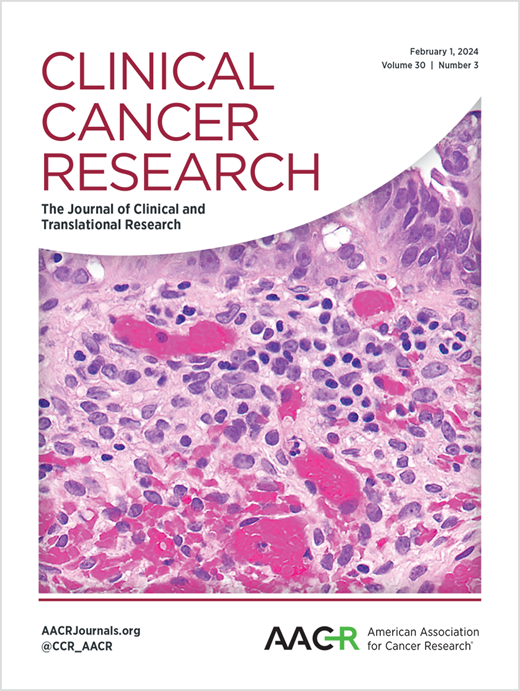空间分析确定肿瘤相关基质富集和MIF作为原发性尤文氏肉瘤的潜在免疫治疗靶点。
IF 10.2
1区 医学
Q1 ONCOLOGY
引用次数: 0
摘要
目的肿瘤微环境(Tumor Microenvironment, TME)在肿瘤的生存和发展中起着至关重要的作用,并可能在耐药和免疫逃逸中发挥作用。迄今为止,很少有研究详细描述尤文氏肉瘤(EwS)的TME。实验设计:我们对有或无临床转移的患者的原发性treatment-naïve EwS肿瘤活检进行了空间分辨转录组学分析,并辅以高plex空间蛋白质组学分析。结果我们发现,与转移相关的EwS原发肿瘤相比,局部EwS原发肿瘤中基质的富集程度更高。通过空间配体-受体分析,我们发现基质富集区具有独特的细胞外基质相关细胞因子、免疫募集和促炎微环境信号,提示EwS基质可能作为免疫募集中心发挥抗肿瘤作用。所有EwS肿瘤均表达促肿瘤发生的MIF-CD74免疫信号连接,提示潜在的免疫逃避机制。结论除了肿瘤相关基质的免疫募集作用外,我们的研究结果为EwS的TME提供了空间视角,并为MIF作为Ewing肉瘤免疫治疗的潜在靶点的临床前研究提供了依据。本文章由计算机程序翻译,如有差异,请以英文原文为准。
Spatial profiling identifies tumor-associated stroma enrichment and MIF as potential immunotherapy targets in primary Ewing sarcomas.
PURPOSE
The Tumor Microenvironment (TME) has a vital role in cancer survival and progression, and may play roles in drug resistance and immune escape. To date, few studies have detailed the TME of Ewing sarcoma (EwS).
EXPERIMENTAL DESIGN
We performed spatially resolved transcriptomics of primary treatment-naïve EwS tumor biopsies from patients with or without clinical metastasis, complemented by high-plex spatial proteomic analysis.
RESULTS
We discovered greater stromal enrichment in localized EwS primary tumors compared to metastasis-associated EwS primary tumors. Through spatial ligand-receptor analysis, we show that the stromal enriched regions harbor unique extracellular matrix related cytokines, immune recruitment and proinflammatory microenvironmental signals, implying EwS stroma may play an anti-tumor role by acting as an immune recruitment center. All EwS tumors expressed pro-tumorigenic MIF-CD74 immune signaling connectivity, suggesting a potential immune-evasive mechanism.
CONCLUSIONS
In addition to the immune recruitment role of tumor-associated stroma, our findings provide spatial insight into the TME of EwS and provide a rationale for the preclinical investigation of MIF as a potential target for Ewing sarcoma immunotherapy.
求助全文
通过发布文献求助,成功后即可免费获取论文全文。
去求助
来源期刊

Clinical Cancer Research
医学-肿瘤学
CiteScore
20.10
自引率
1.70%
发文量
1207
审稿时长
2.1 months
期刊介绍:
Clinical Cancer Research is a journal focusing on groundbreaking research in cancer, specifically in the areas where the laboratory and the clinic intersect. Our primary interest lies in clinical trials that investigate novel treatments, accompanied by research on pharmacology, molecular alterations, and biomarkers that can predict response or resistance to these treatments. Furthermore, we prioritize laboratory and animal studies that explore new drugs and targeted agents with the potential to advance to clinical trials. We also encourage research on targetable mechanisms of cancer development, progression, and metastasis.
 求助内容:
求助内容: 应助结果提醒方式:
应助结果提醒方式:


